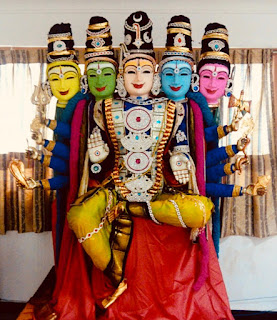Parā
In the next few nāma-s Her Śabda (sound) Brahman form is going to be discussed. The literal meaning of ‘Brahman’ is growing, developing, swelling, expanding, evolving etc.
In a human being Brahman or Maya or the Absolute is said to be in the form of kuṇḍalinī energy ,posited in mūlādāra cakra or base cakra. Sound originates from this Absolute form. There are three stages in manifestation of the Absolute. Its called parā in the unmanifested form and is considered as supreme and is full of energy.
प्रत्यक्-चिती-रूपा (367)
Pratyak-citī-rūpā
Pratyak means turned towards the inner soul and cit means consciousness. She is in the form of inner consciousness which is known as inner Self.
पश्यन्ती (368)
Paśyantī
Paśyantī is the second stage in the evolution of sound, the primary stage being Para.
परदेवता (369)
Paradevatā
She transports power to other gods and goddesses, meaning that She is the supreme amongst gods and goddesses.
मध्यमा (370)
Madhyamā
The next higher level of paśyantī is madhyamā. This stage is called intermediary stage between the origin and the end of speech.
वैखरी-रूपा (371)
Vaikhari-rūpā
Vaikhari is the fourth and final form of sound in its evolution. This is the state wherein the sound is heard.
भक्त-मानस-हंसिका (372)
Bhakta-mānasa-haṁsikā
Hamsa means Swan.
The swans have a few exceptional qualities. If water and milk is mixed, swans consume only the milk leaving water alone. This nama says that one should take cognizance of only good things, leaving bad things aside, though the world exists as the mixture of the two. She acts as a Swan in the minds of Her devotees.
कामेश्वर-प्राण-नाडी (373)
Kāmeśvara-prāna-nāḍī
She is the vital force of Kāmeśvara, the Supreme form of Śiva. The eternal Śiva cannot function without Śaktī and by the effect of Her māyā the universe exists today. That is why She is called the life energy of Śiva.
कृतज्ञा (374)
Kṛtajñā
She is aware of all the actions of the universe. She is capable of transcending the secrecy or privacy, which ignorant men think that nobody is capable of hearing or seeing.
Kṛtajñā also means "a person who includes within himself all the good things that other people do. He is the sum total of all good things in the world".
काम-पूजिता (375)
Kāma-pūjitā
She is worshipped by the lord of love Manmatha.
शृङ्गार-रस-संपूर्णा (376)
Śṛṅgāra-rasa- saṁpūrṇā
She is in the form of essence of love.
ज़या (377)
Jayā
She remains victorious. She is the embodiment of victory.
जालन्धर-स्थिता (378)
Jālandhra-sthitā
Jālandhara pīṭha refers to the heart cakra, where the sound is further refined, to become madhyama, the penultimate stage of sound before its actual delivery. This is one of Her Śabda Brahman forms.
ओड्याण-पीठ-निलया (379)
Oḍyāṇa-pīṭha-nilayā
She dwells in the oḍyāṇa-pīṭha, the fourth pīṭha of the gross body. The fully developed sound at this stage is delivered in the form of vaikari. The oḍyāṇa-pīṭha, corresponds to the throat cakra or viśuddhi.
बिन्दुमण्डल-वासिनी (380)
Bindumaṇḍala-vāsini
She dwells in the bindu maṇḍala. The bindu is the central dot of Śrī Cakra where She resides along with Her consort Kāmeśvara. This point of Śrī Cakra is considered as the most powerful point because it is the abode of both Kāmeśvara and Kāmeśvarī.






No comments:
Post a Comment